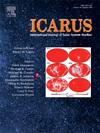Particle size and albedo effects on emissivity spectra of lunar analog minerals and rocks in the intermediate infrared region
IF 3
2区 物理与天体物理
Q2 ASTRONOMY & ASTROPHYSICS
引用次数: 0
Abstract
Visible/near-infrared (VNIR) and thermal infrared (TIR) spectroscopy have been widely used to detect and characterize the abundances of silicates across the solar system. Recently, intermediate infrared (IMIR) reflectance spectroscopy (∼4 - 6 μm) has been proposed as a tool to quantify the Mg# in olivine and pyroxene with varying iron, magnesium and calcium content. The lunar surface is composed of rocks with mixed particle sizes and thus quantifying the effects of particle size is extremely important to increase the robustness of IMIR spectroscopy as a tool for lunar surface exploration. Similarly, space weathering has been known to cause optical darkening and affect the spectra of the lunar surface materials across a broad wavelength range. In this study, we have identified the emission features of lunar analog minerals/rocks and their variations with changes in particle sizes and albedo at IMIR wavelengths in simulated lunar environment (SLE). We find that the lunar analog minerals display an increase in emissivity and striking decrease in feature contrast with an increase in particle sizes or decrease in albedo. This study shows that while this wavelength range works well in reflectance space for sample characterization, using it for emissivity measurements via orbital remote sensing or in-situ rovers requires extensive study.
粒度和反照率对中红外区月球模拟矿物和岩石发射光谱的影响
可见/近红外(VNIR)和热红外(TIR)光谱已广泛用于探测和表征整个太阳系的硅酸盐丰度。最近,中红外(IMIR)反射光谱(~ 4 ~ 6 μm)被提出作为定量铁、镁和钙含量不同的橄榄石和辉石中Mg#的工具。月球表面是由混合粒度的岩石组成的,因此量化粒度的影响对于提高IMIR光谱作为月球表面探测工具的鲁棒性至关重要。同样,太空风化也会导致光学变暗,并影响月球表面物质在很宽波长范围内的光谱。在这项研究中,我们确定了月球模拟矿物/岩石在模拟月球环境(SLE)下的发射特征及其随粒径和反照率的变化。我们发现,月球模拟矿物的发射率随粒径的增加或反照率的降低而增加,而特征对比则明显减少。这项研究表明,虽然该波长范围在反射空间中很好地用于样品表征,但通过轨道遥感或原位探测器将其用于发射率测量需要进行广泛的研究。
本文章由计算机程序翻译,如有差异,请以英文原文为准。
求助全文
约1分钟内获得全文
求助全文
来源期刊

Icarus
地学天文-天文与天体物理
CiteScore
6.30
自引率
18.80%
发文量
356
审稿时长
2-4 weeks
期刊介绍:
Icarus is devoted to the publication of original contributions in the field of Solar System studies. Manuscripts reporting the results of new research - observational, experimental, or theoretical - concerning the astronomy, geology, meteorology, physics, chemistry, biology, and other scientific aspects of our Solar System or extrasolar systems are welcome. The journal generally does not publish papers devoted exclusively to the Sun, the Earth, celestial mechanics, meteoritics, or astrophysics. Icarus does not publish papers that provide "improved" versions of Bode''s law, or other numerical relations, without a sound physical basis. Icarus does not publish meeting announcements or general notices. Reviews, historical papers, and manuscripts describing spacecraft instrumentation may be considered, but only with prior approval of the editor. An entire issue of the journal is occasionally devoted to a single subject, usually arising from a conference on the same topic. The language of publication is English. American or British usage is accepted, but not a mixture of these.
 求助内容:
求助内容: 应助结果提醒方式:
应助结果提醒方式:


